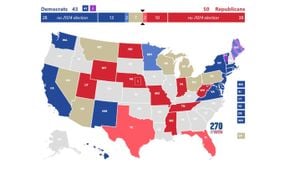On November 5, 2024, Americans took to the polls for one of the most contentious presidential elections in recent history. With tensions high, the stakes couldn't have been clearer: voters were not just choosing between candidates but also defining the character and future direction of their nation. The race, framed as pivotal for democracy and security, saw Democratic nominee Kamala Harris facing off against Republican contender Donald Trump, with both parties trying to capture the attention and support of the electorate.
Unlike their neighbors to the north, Americans cast their ballots directly for their preferred presidential candidate. Yet, as history has shown, the path to victory is determined not solely by the votes cast but by the complex workings of the Electoral College. This mechanism, often criticized for its lack of direct representation, means candidates aim to secure 270 electoral votes, making swing states particularly pivotal.
The election drew record interest—an indicator of the deep divisions within the country. By Monday, over 80.5 million early and mail-in ballots had already been submitted, setting the stage for what was anticipated to be a dramatic voting day. The polls opened across the nation as early as 6 AM ET, with the final ones closing as late as 8 PM local time in Alaska.
Harris and Trump both planned strategic final pitches to voters on Election Day. Harris was set to spend the day engaging directly with potential voters through radio interviews within the key battleground states, underscoring the importance of turning out the base. She was expected to deliver her final speech at the same location where Trump had once addressed supporters before the January 6 Capitol riots, aiming to remind voters of the importance of stability and democratic values.
On the other side, Trump was preparing to speak from his Mar-a-Lago estate, characterized by advisers as not just another rally but as his rebuttal to Harris’s closing arguments. His campaign focused heavily on issues like economic wellness, crime, and what they framed as the dangers of his opponent’s policies.
An interesting phenomenon during this election was the heightened emotion felt across varied demographics. For many, this election day symbolized much more than just choosing the next president; it represented protecting rights, particularly on hot-button issues like abortion and gun control. Abortion rights were particularly highlighted, appearing on ballots across ten different states. With the U.S. Supreme Court's decisions leading to increased state autonomy over such laws, voters recognized the significance their choices would have.
Security was also at the forefront of Election Day. Reports of disruptions were prevalent, particularly from officials anxious about potential interference and unrest. For example, law enforcement was on high alert around Maricopa County, Arizona, aiming to secure the voting process against any unexpected disruptions.
Election Day was brimming with emotion and anticipation. Polling places buzzed from sunrise to sunset, as voters lined up, some waiting hours to exercise their constitutional right. Many individuals brought their families along, sharing the experience as generations discussed the importance of participating in democracy. Eye-catching moments across polling locations included children waiting beside their pet dogs, parents teaching their kids about civic duty, and even unique polling venues, like funeral homes and community centers, becoming artifacts of history.
Despite the intent to maintain order, some polling locations encountered hiccups. Reports surfaced about issues such as malfunctioning voting machines and problems with voter registration, but these were largely managed without significant incident. Election workers diligently addressed the concerns raised by voters, ensuring their ballots were cast fairly.
Public sentiment on social media indicated widespread apprehension. Many expressed anxiety about the potential outcomes, not just for their communities but for the fabric of the nation as well. Popular figures, including characters from children's shows, took part, urging young voters and families to breathe and focus amid the chaos of the day. This sentiment permeated discussions, with closeness of polling and the emotional weight of the election leading to fluctuated mental health among participants.
By the time the polls closed, the die was cast. The results began to trickle in, initially painting broad strokes of victory and loss. Yet, as communities awaited these numbers, it was clear—this was just the beginning. Given the record number of mail-in ballots and early voting, it could take several hours, if not days, for definitive results to emerge. Experts braced for scenarios where various swing states were too close to call, recalling previous elections where results were not clear on election night.
With much riding on this election, commentators noted the likely ramifications not only for U.S. policy but also for international relations. The new presidency would directly impact neighboring Canada, where leaders actively monitored the race, aware of the intertwined economies and cultural connections shared by the two countries. Former U.S. ambassador to Canada warned about the potential changes under another Trump presidency, emphasizing the need for Canadians to gear up for significant political shifts.
Once victory is claimed, whether by Harris or Trump, the political climate and the nation's approach to pressing issues—such as climate change, economic stability, and social equity—will inevitably shift dynamics on both sides of the border. Regardless of the outcome, this election represented the voices of millions, united and divided, sharing their hopes for the future.



